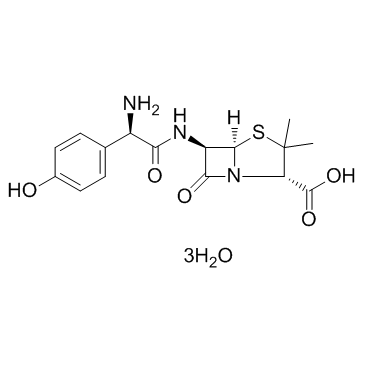61336-70-7
| Name | amoxicillin trihydrate |
|---|---|
| Synonyms |
4-Thia-1-azabicyclo[3.2.0]heptane-2-carboxylic acid, 6-[[(2R)-2-amino-2-(4-hydroxyphenyl)acetyl]amino]-3,3-dimethyl-7-oxo-, (2S,5R,6R)-, hydrate (1:3)
(2S,5R,6R)-6-{[(2R)-2-Amino-2-(4-hydroxyphenyl)acetyl]amino}-3,3-dimethyl-7-oxo-4-thia-1-azabicyclo[3.2.0]heptane-2-carboxylic acid trihydrate Amoxicillin Trihydrate Amoxycillin trihydrate MFCD00072029 AmoxicillinTrihydrate Amoxicillin (trihydrate) |
| Description | Amoxicillin Trihydrate is a moderate- spectrum, bacteriolytic, β-lactam antibiotic.Target: AntibacterialAmoxicillin is a moderate-spectrum, bacteriolytic, β-lactam antibiotic in the aminopenicillin family used to treat bacterial infections caused by susceptible Gram-positive and Gram-negative microorganisms. It is usually the drug of choice within the class because it is better-absorbed, following oral administration, than other β-lactam antibiotics. Amoxicillin is susceptible to degradation by β-lactamase-producing bacteria, which are resistant to a narrow spectrum of β-lactam antibiotics, such as penicillin. For this reason, it is often combined with clavulanic acid, a β-lactamase inhibitor. This increases effectiveness by reducing its susceptibility to β-lactamase resistance. From Wikipedia. |
|---|---|
| Related Catalog | |
| References |
| Density | 1.54g/cm3 |
|---|---|
| Boiling Point | 743.2ºC at 760 mmHg Vapour |
| Melting Point | >200ºC (dec.) |
| Molecular Formula | C16H25N3O8S |
| Molecular Weight | 419.450 |
| Flash Point | 403.3ºC |
| Exact Mass | 419.136230 |
| PSA | 185.95000 |
| LogP | 0.85990 |
| Index of Refraction | 302 ° (C=0.1, H2O) |
CHEMICAL IDENTIFICATION
HEALTH HAZARD DATAACUTE TOXICITY DATA
|
| Symbol |

GHS08 |
|---|---|
| Signal Word | Danger |
| Hazard Statements | H317-H334 |
| Precautionary Statements | P261-P280-P342 + P311 |
| Personal Protective Equipment | dust mask type N95 (US);Eyeshields;Faceshields;Gloves |
| Hazard Codes | Xn:Harmful |
| Risk Phrases | R42/43 |
| Safety Phrases | S36 |
| RIDADR | NONH for all modes of transport |
| RTECS | XH8300000 |
| HS Code | 2941109200 |
| HS Code | 2941109200 |
|---|


